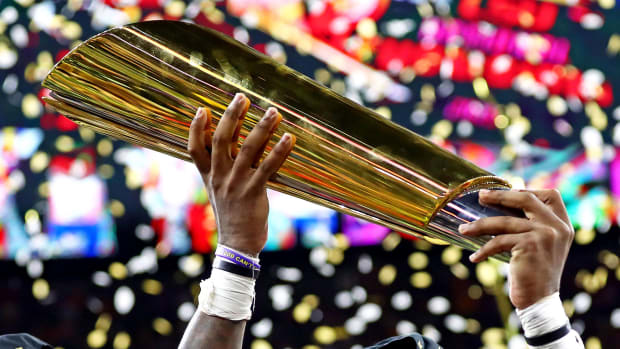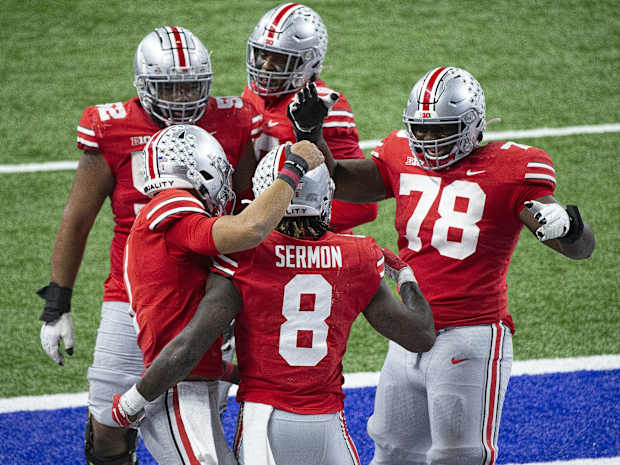Years from now, will this season's champion have an asterisk in the record books?
NEW ORLEANS — In the official NCAA Division I Football Record Book, there is no section listing national champions of the highest level of the sport: the Football Bowl Subdivision.
Having never been involved in hosting an FBS championship, the governing body of college athletics does not recognize title winners in the same way it does for every other sport. The FCS record book, for instance, features a chapter devoted to FCS Playoff winners. The men’s basketball record book has a section about March Madness participants and champions.
But the FBS? Nothing.
However, the NCAA has added to its website a link to a page listing FBS champions determined by the most respected polls of that particular era. Of the 151 years listed—including 187 total champions (32 years featured at least two champs)—just one year carries with it the dreaded and unmistaken symbol of the asterisk: 2004, Southern California.
One sentence is scrawled in italics at the bottom of the page.
*Southern California’s participation in the 2004 championship was vacated by the NCAA Committee on Infractions.

There are no asterisks beside any of the early years of the sport, when participation in college football was almost exclusive to the Ivy Leagues, resulting in all Ivy League champions for its first 31 years. There are no asterisks beside 1943 or 1944 or 1945, when World War II caused an influx in talent at military academies, which transformed into football powerhouses by using their former rivals’ players against them on the gridiron.
Maybe most notably, there is no asterisk beside 1918, when a combination of World War I and the influenza pandemic caused such disruption in the sport, with travel and health restrictions, that some teams played one game and others played nine. One conference completely canceled its season, in fact, and it was quite normal for teams, having had an opponent cancel, to schedule a game within a week’s time.
Sound familiar?
“I don’t think anything is really comparable to this year,” says Kent Stephens, a longtime college football historian at the College Football Hall of Fame, “but the 1918 season would be the closest. The season was cut short on Oct. 1 and then restarted in November, not because of the flu but because of World War I. It shut everything down. It killed a lot of the schedules.”
One hundred and two years later, a similarly disrupted college football season is winding down. At its very end, as the College Football Playoff semifinals arrive this Friday, a question is emerging: How will history view the champion of this weird, wacky 2020 season?
The answer is rooted in history itself. Just like in 1918, when Pittsburgh and Michigan split the title, and in ’44–45, when Army lorded over a war-torn sport, the champion will be … the champion.
Sure, there may be an argument about such a topic now, and maybe there will still be an argument next year or the year after. But how about 25 or 50 years? Don’t count on it.
“A few years down the road, they become just another national championship in the book,” says Jeremy Swick, the curator and historian at the College Football Hall of Fame. “I don’t think this season questions any legitimacy in that.”
In fact, some college athletic leaders believe that this year’s champion is more deserving than most. They’ve had to withstand sudden game cancellations, quarantine or isolate for weeks at a time and win games without key players who are impacted by COVID-19 protocols.
Clemson spent an entire week preparing for Florida State only for the Seminoles to cancel the game the morning of, and Ohio State played a game without three starting offensive linemen. Alabama’s coach, Nick Saban, missed a game after testing positive, and Notre Dame had four off weeks in a span of about two months.
“It’ll be judged the same way as MLB and NBA and other champions,” says Clemson athletic director Dan Radakovich. “They all had truncated seasons. The Lakers and Dodgers are celebrating. Those teams deserved it. This shouldn’t have an asterisk next to it.”
But wait, maybe it should?
Arkansas AD Hunter Yurachek says the 2020 champion should be identified as unique—for good reasons.
“This year can have the asterisk by it, but it means something more, not something less,” says Yurachek. “We’re going to put an asterisk by this year because we all survived it.”
So … asterisk or no asterisk?
“Great question,” Florida AD Scott Stricklin says. “Right now, it’s speculation. Until we get on history’s side of this, I don’t think we have that answer. It’s going to be interesting on how we look back at this. My guess is it’ll be looked back on as ‘The Chaotic Year: pandemic, election and social unrest.’ ”
Asterisk or not, SEC commissioner Greg Sankey has shared a quote with his athletic directors throughout this year.
“Whoever wins a championship this year is going to have to go through something no one has gone through,” recalls Texas A&M AD Ross Bjork.
There have been similar seasons. Like 1918, when so many teams played a differing number of games—a criticism about this year’s Buckeyes, who have played six games compared with the other playoff participants, which have each played 11.
The issue has reached some of the sport’s highest levels, with Clemson coach Dabo Swinney critical of OSU’s inclusion in the playoff field based on the game differential. Swinney, a voter in the coaches poll, ranked the Buckeyes No. 11 on his final ballot. In a news conference Monday, Swinney explained that a prerequisite for his top 10 was nine games played.
“I just don't think it's right,” he said. “It's not that they're not good enough. I just don't think it's right that three teams have to play 13 games to be the champion and one team has to play eight. So if people have a problem with that, I don't really care. It's my poll. And it doesn't matter who the [team] was. It has zero to do with Ohio State.”

In 1918, a year with varying numbers of games played, Pittsburgh was retroactively named champion despite playing just five games, including a season-ending 10–9 loss to Cleveland Naval Reserve, a team of college football all-stars amassed as players joined the military ranks for World War I preparation.
Michigan, at 5–0, joined them in a split title. That year, Texas finished 9–0, and Oklahoma was 6–0. Texas A&M finished 6–1, with its only loss at Texas by a score of 7–0.
Argue all you want now, but they didn’t do much of it back then, says Stephens.
“College football was a regional sport,” he says. “There wasn’t a lot of noise about a national champion. Teams were more worried about ‘Am I the best team in the South or the West?’ There wasn’t a concern or debate who the national champion was.”
Now of course, there is.
There hasn’t been a recognized split national title in college football since 2003, when the Associated Press crowned USC as champions in the same year when LSU won the BCS title. And the only way it’ll happen this year, experts say, is if Ohio State wins it all. Even then, it’s a longshot. Would AP or coaches’ voters really penalize the Buckeyes, then 8–0, for playing so few games by stripping away a championship after they beat two of this year’s playoff participants? After all, they are No. 4 in both polls entering the playoff.
“I’ve been playing around most of the year with the average number of games these teams are playing,” Stephens says. “As of a couple of weeks ago, the average D-I team played about 8.4 games this year. If Ohio State has eight games and the average team plays eight and a half, I think that will legitimize it in my mind.”
Stephens pauses for a minute and chuckles.
“But I went to grad school there, so of course I’d say that.”
Asterisk or no asterisk, split national title or solo champion, history’s view of the 2020 title winner(s) will be one shrouded in mystery until it is, well, history.